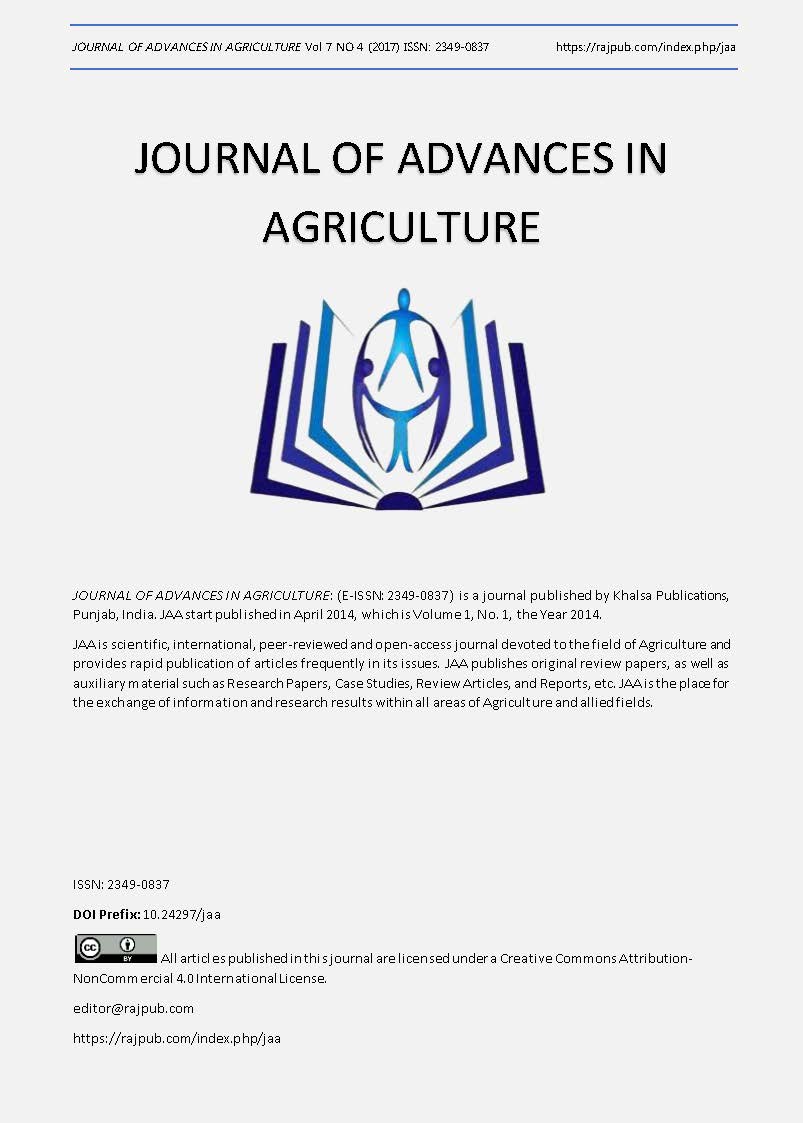GENOTYPE AND TIME OF INOCULATION EFFECTS ON DON PER GRAIN AND GRAIN WEIGHT OF WINTER WHEAT UNDER TWO ENVIRONMENTAL CONDITIONS
DOI:
https://doi.org/10.24297/jaa.v7i4.6358Keywords:
DON, dwarfing, alleles, Fusarium, genotype, Mercia, timingAbstract
Experiment was conducted using near isogenic lines of Mercia background in a controlled environment to evaluate the mean effect of timing of inoculation and subsequent increase in temperature on deoxynivalenol (DON) concentration, amount of DON per grain and grain weight. The experiment was completely randomised consisting of three genotypes differing in semi-dwarfing alleles; Mercia 0 {Rht-B1a + Rht-D1a (wild type)}, Mercia 1 (Rht-B1b) and Mercia 2 (Rht-D1b) and four inoculation timings. The experiment was a complete factorial combination with four randomised replicates. Data showed that genotype differed in DON concentration (P<0.001), DON per grain (P=0.006) and mean grain weight (P=0.001) while time of inoculation influenced mean grain weight (P<0.001) and DON Concentration (P<0.001) but not Don per grain (P=0.23). Temperature influenced mean grain weight (P=0.002) with high temperature adversely affecting the size of the wheat grains.
Downloads
References
2. Cowger, C., Arellano, C. 2010. Plump kernels with high deoxynivalenol linked to late Gibberella zeae infection and marginal disease conditions in winter wheat. Phytopathology 100: 719-728.
3. Del Ponte, E.M., Fernandes, M.C., Bergstrom, G.C. 2007. Influence of growth stage on Fusarium head blight anddeoxynivalenol production in wheat. Phytopathology 155: 577-581.
4. Edwards, S.G., Pirgozliev, S.R., Hare, M.C., Jenkinson, P. 2001. Quantification of Trichothecene-producing Fusarium species in harvested grain by competitive PCR to determine efficacies of fungicides against Fusarium head blight of winter wheat. Applied and Environmental Microbiology 67: 1575-1580.
5. Farooq, M., Bramley, H., Palta, J.A. Siddique, K.H.M. 2011. Heat stress in wheat during reproductive and grain-filling phases. Critical Reviews in Plant Sciences 30: 491-507.
6. Flintham, J. E., Borner, A., Worland, A.J., Gale, M. D. 1997. Optimizing wheat grain yield: effects of Rht (gibberellin-insensitive) dwarfing genes. Journal of Agricultural Science 128: 11-25.
7. Gosman, N., Bayles, R., Jennings, P., Kirby, J., Nicholson, P. 2007. Evaluation and characterization of resistance to Fusarium head blight caused by Fusarium culmorum in UK winter wheat cultivars. Plant Pathology 56: 264-276.
8. Lukac, M., Gooding, M.J., Griffiths, S., Jones, H. 2012. Asynchronous flowering and within-plant flowering diversity in wheat and implication for crop resilience to heat. Annals of Botany 109: 843-850.
9. Mesterhazy, A. 1995. Types and components of resistance to Fusarium head blight of wheat. Plant Breeding 114: 377-386.
10. Miedaner, T., Voss, H.H. 2008. Effect of dwarfing Rht genes on Fusarium head blight resistance in two sets of near-isogenic lines of wheat and check cultivars. Crop Science 48: 2115-2122.
11. Schaafsma, A.W., Savard, M.E., Clear, R., Dexter, J. 2004. Methods and issues regarding detection of deoxynivalenol, Fusarium-damaged kernels, and Fusarium spp. in commercial grain Canada. Canadian Journal of Plant Pathology 26: 443-452.
12. Semenov, M., Shewry, P.R. 2011. Modelling predicts that heat stress, not drought, will increase vulnerability of wheat in Europe. Europe Science Reports-UK 1: 66.
13. Siou, D., Gelisse, S., Laval, V., Repincay, C., Canales, R., Suffert, F., Lannou, C. 2013. Effect of wheat spike infection timing on Fusarium head blight development and mycotoxin accumulation. Plant Pathology 63: 1-9.
14. Stack, R.W. 2003. History of Fusarium head blight with emphasis on North America. In: K.J. Leonard and W.R. Bushnell, editors, Fusarium head blight and barley. APS Press, St. Paul, MN, USA, Pp 1-34.
15. Van der Fels-Klerx, H.J., van Asselt, E.D., Madsen, M.S., Olesen, J.E. 2013. Impact of climate change effects on contamination of cereal grains with deoxynivalenol. PLOS ONE/ www.plosone.org.
16. Wegulo, S. 2012. Factors influencing deoxynivalenol accumulation in small grain cereals. Toxins 4: 1157-1180.
17. West, J.S., Hodgate, S., Townsend, J.A., Edwards, S.G., Jennings, P., Fitt, B.D.L. 2012. Impacts of changing climate and agronomic factors on Fusarium ear blight of wheat in the UK. Fungal Ecology 5: 53-61.
18. Worland, A. J., E. J. Sayers, and V. Korzun, 2001. Allelic variation at the dwarfing gene Rht8 locus and its significance in international breeding programmes. Euphytica119: 155-159.
19. Youssefian, S., Kirby, E.J.M., Gale, M.D. 1992. Pleiotropic effects of the GA-insensitive Rht dwarfing genes in wheat. 2. Effects on leaf, stem, ear and floret growth. Field Crops Research 28: 191-210.
Downloads
Published
How to Cite
Issue
Section
License
 All articles published in Journal of Advances in Linguistics are licensed under a Creative Commons Attribution 4.0 International License.
All articles published in Journal of Advances in Linguistics are licensed under a Creative Commons Attribution 4.0 International License.




